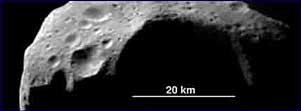Now an Italian group of researchers has reviewed various scientific literature and seismic recordings on the event, studied the site since 1999 and surveyed some 60,000 fallen trees, and translated additional eyewitness accounts from Russian.
The researchers say the event was likely caused by a low-density asteroid that exploded in the atmosphere, sending out a firestorm that burned trees and a shock wave that did more damage, according to a story on the BBC's web site. The explosion was equal to more than 10 million tons of TNT, the researchers say.
|
|
|
Asteroid Mathilde, photographed in 1997 by the NEAR-Shoemaker probe, is a loose "rubble pile" similar to the asteroid scientists believe exploded over Tunguska in 1908. |
The event itself has become legendary. On June 30, 1908, something fell from the sky over the Tunguska region of Siberia, but did not quite hit the ground. Instead it burned and flattened a vast region of forest, while leaving behind few other clues. No crater. No discernable extraterrestrial material. Witnesses reported a loud blast and a bright flash. Fine dust in the atmosphere reportedly brightened the night sky as far away as London for 48 hours.
Almost no one lived near blast site, however, save a few hunters and trappers. No one studied the site until 1930. And while scientists have long presumed an asteroid or comet exploded just above the surface, no consensus has been reached. Some even suggested a miniature black hole did the work.
The object seems to have approached Tunguska from the southeast at about 11 km per second (7 miles a second), the BBC reported.
Why did the asteroid break apart in the air?
"Possibly because the object was like asteroid
Mathilde, which was photographed by the passing Near-Shoemaker space probe in 1997," researcher Luigi Foschini told the BBC. "Mathilde is a rubble pile with a density very close to that of water. This would mean it could explode and fragment in the atmosphere with only the shock wave reaching the ground."A scientific paper on the work will be published in an upcoming issue of Astronomy & Astrophysics

